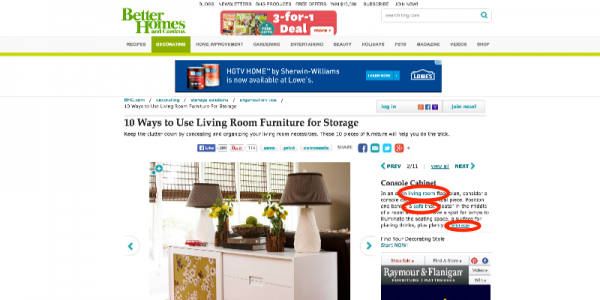 Use these great website design ideas for increasing page views and decreasing bounce rates
Use these great website design ideas for increasing page views and decreasing bounce rates
Reader engagement is a key metric important to all publishers. Time spent, pages per visit and return visits are all numbers that every online publisher should hold near and dear.
The problem with the information overload of the internet is that website readers get lazy. When they come in from search engines, they often click, find what they’re looking for and head off in another direction.
However, if you give them better reasons to click, they’re more likely to keep digging.
[text_ad]
There’s doing it right, and there’s doing it the right way
A few years ago, a little site called Men’s Health saw an astounding 78.3% increase in page views simply by adjusting their article navigation and breaking up stories into sections, where the user needed to click “next” to continue reading.
Not bad, right?
On the other end of things, a publisher we watch that typically gets 2.8 million unique visitors per month dropped a whopping 59% in page views in the past year. This was directly after consolidating long articles into slideshows and transforming their news-centric homepage into a Pinterest look-alike.
However, this isn’t to say that images and slideshows don’t work, it’s just about doing them right. Better Homes and Gardens website saw a 21% increase in page views back when they introduced slideshows. The difference between the two examples is that BHG never writes a fifty-word slideshow snippet without inter-linking at least once, but usually three to five times.
How you can get people to keep on clicking
If you’re ad-driven, getting people to click more is a need-to-know. But even if you’re in direct sales, you can build rapport with a visitor just through a few pages. Here are some ideas:
1. Use featured images – A great image can supplement an otherwise boring or uninteresting headline.
2. Add related posts to your page – The most basic way to get more clicks is to include a list of related articles below your feature. Typically these are chosen based on similar tags.
3. Open external links in a new window: This is a general rule in terms of keeping people on your site, but it’s especially important for keeping your technical bounce rate low.
4. Be what they’re looking for: If you get a lot of traffic on a keyword, but have a high bounce rate, then you’re probably not answering their question. Revise high-bounce articles to make them more helpful and inter-link them to related topics so that visitors will be more likely to keep browsing.
5. Give something away for free: We always promote a free report through text ads right in the middle of our articles. What better way to keep people engaged than to give them something for free?
6. Make your editors superstars: Too many websites don’t have author pages, even though visitors often want to read more about the people who are writing the articles. Include a photo and a link to your author’s bio.
7. Interlink articles: It is possible to link to yourself too much in an article, but as long as you’re linking to related articles, your users will want to click to find out more.
8. Create a glossary: By creating a glossary, you can easily link to any words that are industry jargon. That way nobody is clicking away to look up the definition of any funny words. At Mequoda, we also add related articles to our glossary landing pages.
9. Write index posts: Write resource or “best of” lists often so you can frequently refer back to old articles that could use a boost. SEO is the best way to recycle old content, and index posts are the next best way! They also make it easy for lazy visitors to click!
10. Add a search box: If people can’t find what they’re looking for, why would they stay and click?
And one more thing…
If you need another good reason to get people to keep clicking, let’s look at our good friend SEO.
Google’s algorithm pays close attention to bounce rates on the search results that they list. If someone clicks a link in their results and immediately hits the back button and comes back to the results page to click on another article, Google takes notice.
Too many bounces from your listing can cause Google to drop you deeper and deeper into their results. So it’s important that when someone clicks on your article in a search engine, you keep them on your page for a little while.



